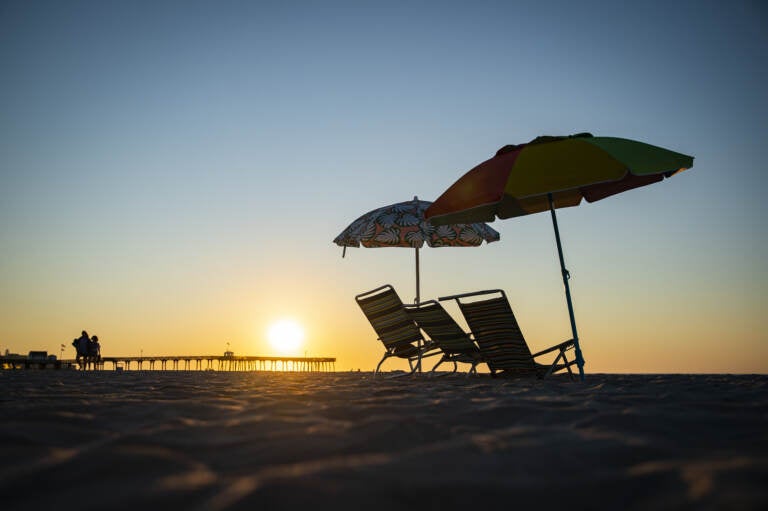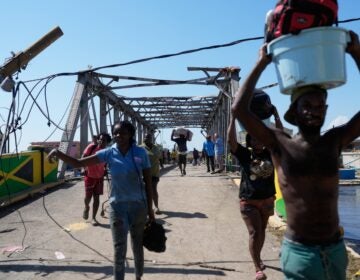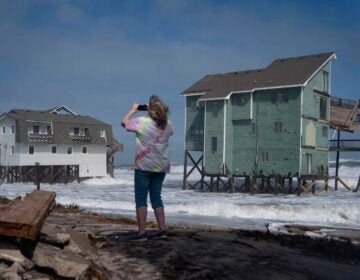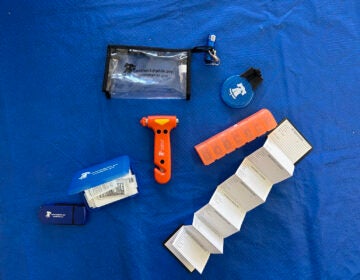The first hurricane of the season arrived late, but don’t let your guard down

Beach chairs are seen as the sun rises in Ocean City, N.J., on Aug. 18. This is not the above-average hurricane season experts predicted — at least, not yet. (Al Drago/Bloomberg via Getty Images)
For months, the 2022 Atlantic hurricane season was notable for one reason: a complete lack of hurricanes. That finally changed on Friday, when Danielle strengthened into the Atlantic’s first hurricane since last October.
The 2022 season had been predicted to continue the recent run of storm activity that pushed meteorologists deep into their annual list of alphabetized storm names, even exhausting it entirely.
But so far, it’s been a quiet summer: 60 days elapsed from Tropical Storm Colin’s demise on July 3 and Danielle’s arrival on Sept. 1.
“No tropical cyclones formed in the basin during August,” as the National Hurricane Center said in its monthly recap. “This is quite unusual and is the first time that has occurred since 1997, and is only the third time that has happened since 1950.”
Weather conditions can change rapidly, and dangerous storms could still form in the coming weeks, experts warn. Just days after Danielle formed, for instance, another tropical storm, Earl, formed.
Why is there a gap between the prediction and reality?
This is not the above-average hurricane season experts predicted — at least, not yet. Scientists at Colorado State University and the National Oceanic and Atmospheric Administration predicted the Atlantic’s seventh above-normal season in a row, with more than the average of 14 named storms.
Their reasons were solid: The climate pattern known as La Niña in the Pacific Ocean normally brings a more active hurricane season in the Atlantic. In addition, water temperatures in the tropical Atlantic have been among the warmest ever recorded, providing plenty of fuel for storms.
“Those two factors alone were expected to drive an active Atlantic hurricane season, but it hasn’t turned out that way,” meteorologist Jeff Masters told NPR. He’s a hurricane expert for Yale Climate Connections and a co-founder of Weather Underground.
“It was not expected and the reasons for it are not well understood,” Masters said (more on that below).
What does history say about a slow start to storm season?
It’s a mixed picture, with a small sample size. But experts warn not to assume there’s less risk just because the first months of hurricane season have been calm.
Since routine aircraft reconnaissance began in 1944, only two other seasons didn’t see a named storm in August. The first came in 1961, which pivoted into a very active season. A flurry of dangerous hurricanes formed in September alone — including Hurricane Carla, which devastated the Texas coast.
The second such season, in 1997, remained a quiet one. But Jamie Rhome, acting director at the National Hurricane Center, noted in a statement sent to NPR that in 1992, the storm season had also been quiet, before Hurricane Andrew struck South Florida and Louisiana in August.
“It only takes one landfalling hurricane to make it a bad season for you, and we still have three months to go before the end of the Atlantic hurricane season,” Rhome said.
So, what’s happened so far this year?
Hurricanes, it turns out, have two big enemies: dry air and wind shear. This year, those conditions are being boosted by the Bermuda High, a high-pressure system that sits over the Atlantic Ocean.
The Bermuda High is currently smaller and farther north than normal — leading to high temperatures from Canada to Europe. It’s also allowing the powerful jet stream to dip far to the south over the central Atlantic, preventing hurricanes from forming.
“When high winds get up on top of a developing system that’s trying to be a hurricane, those high winds will tear it apart,” Masters said.
The same dynamic is funneling dry air to the Atlantic that also saps storms.
“Things are all upside-down” this summer, a hurricane expert says
Climate change is causing hurricanes to get more powerful on average. In general, air that’s becoming warmer and more moist provides more fuel for extreme weather, from hurricanes to intense inland storms. Researchers are still working to learn how rising temperatures might affect the overall number of storms that form.
“Hurricanes fundamentally form in response to unequal heating of the poles compared to the equator. They’re meant to redistribute heat,” Masters said.
But their services have not been required this summer, because sunny conditions have brought heat waves to northern latitudes and raised ocean temperatures in the far north to resemble tropical warmth.
With little need for hurricanes to transport heat, the Atlantic isn’t the only place seeing a calmer storm season.
“The western Pacific has also been super quiet. We’re somewhere around maybe 60% of average activity there,” Masters said. “So it’s kind of a global thing going on here. It’s not just the Atlantic: Things are all upside-down.”
Does this mean we’re in for an easier hurricane season?
We might see less powerful hurricanes compared to recent years, Masters said, but that doesn’t mean they wouldn’t be dangerous. Because of warm ocean temperatures, he expects any cyclone that does form to pack a great deal of water, raising the risk of flooding — the main cause of death from hurricanes.
“It’s unlikely we’re going to have an above-average season now,” he said, noting that the hurricane season is nearing its traditional halfway point of Sept. 10.
But forecasters warn not to become complacent in the absence of hurricanes.
“It’s still early. It only takes one bad storm to make a hurricane season for the ages,” Masters said. “So we still have to be vigilant.”
As Colorado State’s researchers said when they made their seasonal forecast, anyone who lives in an area that could be affected by a hurricane or tropical storm “should prepare the same for every season, regardless of how much activity is predicted.”
9(MDAzMzI1ODY3MDEyMzkzOTE3NjIxNDg3MQ001))




